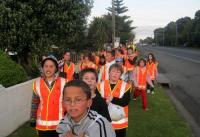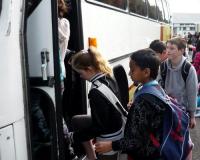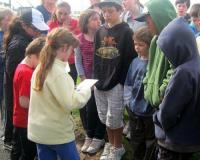Primary students learned the skills to be safe road users in a unit that crossed the curriculum.
A primary school tied earth science and safe travel together in an inquiry unit that also strengthened its teachers' pedagogical knowledge.
Health lessons get intermediate students thinking about road safety in relation to current events.
Hawera Primary School - Smart planning leads a learning journey
When Hawera Primary School classes bussed into the Oaonui natural gas plant, it was time to hear from the experts.
So students from Elizabeth William's class stepped up and spoke about the Maui gas field, explaining gas as a natural feature and how it is used as a resource.
'Before the trip, each class had to become experts in their resource and then when we were on the field trip, the experts had to tell everyone in the group what they knew,' says Elizabeth.
As the trip, dubbed a geological adventure, continued, senior classes took turns to share their new-found expertise on the features of the Taranaki region, including its mountain, coast, and rivers.
Coordination between classes, and the challenge for students to actively demonstrate their knowledge, were two advances Hawera teachers have made in delivering inquiry learning.
Support for their professional development came via the Big Event educational resource, used as a basis for planning the science inquiry and field trip. Created by Pam Hook and Julie Mills for the NZ Transport Agency, the Big Event includes learning experiences in which students explain how smart choices can result in safe travel.
After their field trip, Hawera students created photographic presentations and annotated maps that described the region's geology and its impact on travel.
Teachers were looking for evidence that students had grasped the implications of limited routes in and out of the area, and other risks associated with volcanic eruptions, eroding coast lines, and further natural hazards.
Road safety practices were integrated into the field trip – teachers discussed bus safety with students, who later donned bright vests and used safe crossing techniques when walking to some venues.
Elizabeth says senior syndicate teachers collaborated closely during planning, more so than in the past. Coordination ensured all classes were ready to give their expert presentations, and it simplified professional learning – for example, creating the opportunity to invite a secondary science teacher to speak to staff about the region's geology.
The junior syndicate created another version of the inquiry. Teachers across the school found the Big Event added structure to their plans, says Elizabeth, who guided the planning process.
'It's given us better direction. We may have floundered before that – we knew what we wanted to do but we have struggled to get to the end point.'
Teachers mapped learning intentions from the resource against the school's own inquiry model. They placed define and describe activities in the initial 'hook in' inquiry phase. Later activities required higher levels of thinking skills to explain geological processes and natural hazards, ideal for the final 'reporting' stage in the school's inquiry model.
Elizabeth says this structure gave a clear pathway for students and led to surprise outcomes as children raised their own questions and did additional research.
'The kids have gone further because of the way we started by defining and describing; it's been clearer and it's given them more direction for where they wanted to go.'
Students are increasingly familiar with a common language of learning across the school, using the learning model SOLO Taxonomy.
Principal Neryda Sullivan says teachers want students to know how to learn, and the school has experimented with this model over the past two years, using NZ Transport Agency resources which have SOLO as a design framework. The Big Event includes SOLO rubrics for students to assess their level of learning.
Teacher Sharon Honeyfield says these rubrics guided junior students working on the Big Event.
'It's helped the kids' thinking. It gives them the next steps to improve their learning outcomes.'
In written reflections on their planning experience, teachers thought they had created a resource with “strong directions for deep learning – learning intentions were clear and well aligned”, that planning was not prescriptive, allowing the resource to be modified to suit student needs, and that SOLO-based assessment provided great support for teacher-led inquiry.
Elizabeth says she expects teachers will draw on the resource again where it supports learning, especially future field trips.



